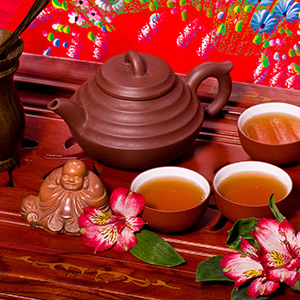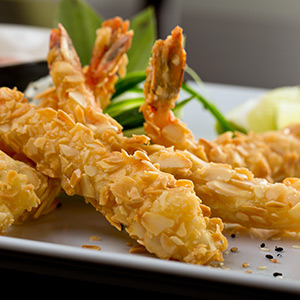Japanese Food and Drink
Although most Japanese have adopted a Western lifestyle, traditional customs remain an essential part of daily life.

The tea ceremony
Dating from the 16th century, the ritual of the tea ceremony continues to be taught today like music or dance. Many homes include a room used only for such occasions. Tea is also enjoyed first thing in the morning and with meals, served without sugar in stoneware or fine china bowls or cups.
Tea is never served at births or weddings because the short, cut tea leaves are considered a symbol of death. Green tea is common and flavoured tea, such as apple, rose and cinnamon, are also popular.
Food presentation
Foods are served in small amounts on individual plates. Soup is served in covered bowls without a spoon. Japanese chopsticks, more slender than the Chinese and usually made of lacquered wood, are used to add ingredients to the soup. The bowl, cupped in both hands, is then raised to the mouth.
Guests sit back on their heels and are expected to admire the dishes before tasting them—audibly to show their appreciation. For the Japanese, food is not just a source of calories to fuel the body, but a spiritual experience. Foods are served as naturally as possible, even raw, so that one comes to truly enjoy and appreciate them.
The Japanese esthetic centres on savouring foods in season. For example, a carrot would be cut in the shape of a flower in the spring, and the shape of a maple leaf in the fall. Summer meals feature crisp green vegetables served with chilled noodles, while a winter meal might include sukiyaki, a beef and vegetable dish cooked at the table. This appreciation of the changing seasons permeates Japanese culture and philosophy.
The seasons also dictate the choice of serveware. For instance, white dishes and bowls are avoided in fall and winter in replace for black and red lacquer, because the colours are thought to enhance the appeal of the season's cuisine.
Favourite dishes
Sushi was invented in Asia before salt was used to preserve food. Fish was rolled up in vinegared cooked rice. As the rice fermented, it salted the fish, preserving it. Modern sushi first appeared in Tokyo food stands in the middle of the 19th century. People ate it standing up, like we eat hot dogs. It was popular cheap fare and the quality depended more on the skill with which it was made than on what went into the filling.
Sushi has become very sophisticated with all kinds of new shapes and names: California sushi, crazy horse, porgy, Boston roll. Tokyo has 15,000 sushi bars in which the sushi is served on a conveyor belt or in miniature boats floating in a small moat. Now, you can find sushi in the refrigerated display case at your grocer's and enjoy it at home.
Sashimi is made with the best cuts of raw fish and seafood, such as tuna, salmon, squid and bream. It is served with a mixture of soya sauce and wasabi (green horseradish) that add bite, but still let the flavour of the fish come through. Soya sauce has been in use since 710 and produced industrially since the 16th century. Daikon, a large white radish, is usually served with sashimi.
Tempura is a variation on a dish introduced by the Portuguese in the 16th century. They observed the Catholic days of refraining from eating meat, and asked for shrimp fried in batter instead. The Japanese refined the dish, perfecting a light batter so fine that it's practically transparent. Fish, seafood and vegetables are dipped in this batter then fried until just cooked and crispy.
Tradition dictates that a Japanese meal end with green tea, but another option is serving sake. In the winter, hot sake warms the body, while in the summer, it can be enjoyed cold. Sake is served in tiny cups called sakazuki. According to Japanese sake etiquette, one never fills one's own glass.












.jpg)




